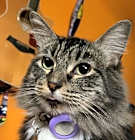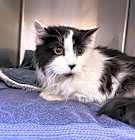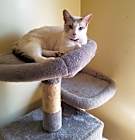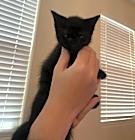On average, male Ragdolls can weigh anywhere from 10 to 20 pounds and stand around 9 to 11 inches tall. Ragdoll cats are known for their substantial size.
Ragdoll
Breed Type: Western
Coat: Long-haired
Hypoallergenic: No, they will likely trigger allergies.
Temperament: Affectionate, gentle, friendly, sociable
Life expectancy: 12-20 years
Color & patterns:

Get ready to be completely smitten by the Ragdoll cat. These delightful fluff balls, with their large, dreamy blue eyes, color-pointed coats, and supremely plush tails, are the perfect mix of a gentle giant and a teddy bear, with a dash of dog-like loyalty thrown in for good measure. As soon as you enter the room, Ragdolls are eager to flop into your arms and surrender to belly rubs and chin scratches, hence their name. Ragdolls are also renowned for their exceptional sociability and people-pleasing personalities. They get along with everyone — children, other pets, even the mailman. They’ll happily follow you from room to room, offering their companionship at every turn. If you’re looking for a cat who is equal parts cuddle bug and goofball, the Ragdoll is the cat for you.
Ragdoll characteristics
Learn about about Ragdoll basics like their fur colors, shedding levels, how much grooming they need, and other Ragdoll facts.
Average height
9-11 inches (22.9-27.9cm)
Average weight
10-20 pounds (4.5-9.1 kg)
Average lifespan
12-20 years
Good with other cats
Good with dogs
Affection
Shedding
Health
Exercise needs
What eye colors can a Ragdoll have?
Ragdoll cats are known for their stunning blue eyes, often called “blue almond-shaped eyes.” These striking blue eyes are a hallmark of the breed, but Ragdolls can also have slight variations in shade, ranging from a deep sapphire blue to a lighter, more aqua-like blue or even green, gold, yellow, or two different eye colors.
Are Ragdoll cats polydactyl?
No, Ragdoll cats are not commonly polydactyl. Polydactyly is a genetic trait that results in cats having extra toes on their paws, and some cat breeds, like the Maine Coon, are more commonly associated with it.
What type of coat do Ragdoll cats have?
Ragdoll cats have soft, semi-long, silky coats. Their fur is not as short as that of some other cat breeds but not as long as others, such as a Persian cat’s fur.
Do Ragdoll cats shed?
Yes, Ragdoll cats shed. Ragdolls tend to shed moderately throughout the year, with potential increases in shedding during seasonal changes. Shedding is a natural process for cats, and while you can manage it, you can’t completely eliminate it, so be prepared for some occasional fur cleanup around your home.
What does a Ragdoll cat look like?
Ragdoll cats have soft, semi-long coats that can vary in color and pattern but can be colorpoint, mitted, bi-color, and van. They have color points on the ears, face, paws, and tail. These cats have robust and muscular bodies and tufted paws. Their heads are broad and flat-topped, and they are known for their large, captivating blue eyes and long, bushy tails.
What is the most popular Ragdoll color?
The most popular Ragdoll cat color is the seal colorpoint. The colorpoint pattern features a lighter body color with darker color points on the ears, face, paws, and tail. The classic seal colorpoint, which is the most traditional and widely recognized, consists of a rich, dark brown color for the points and a creamy beige or fawn body.
Ragdolls also come in other various colors and patterns, including blue colorpoint, chocolate colorpoint, and more.
How long do Ragdoll cats live?
On average, Ragdolls tend to live 12 to 15 years. Of course, just like humans, genetics and lifestyle play a role, as does receiving proper care and a balanced diet, so some Ragdolls may stretch their years beyond that range, while others might not.
What breeds make a Ragdoll cat?
The Ragdoll was bred from Burmese, Birman, and Persian pure-bred cats and a stray mixed-breed cat.
When does a Ragdoll stop growing?
Ragdoll cats typically stop growing at around three to four years of age. Male Ragdolls tend to take a bit longer to reach their maximum size compared to females.
Are Ragdoll cats hypoallergenic?
No, Ragdoll cats are not hypoallergenic. While Ragdolls have less dense undercoats than some other breeds, reducing the amount of loose fur and dander, it doesn’t make them hypoallergenic. Like most other cat breeds, Ragdolls produce allergenic proteins in their skin, saliva, and urine, which can become airborne, settle on surfaces, and trigger allergies in susceptible individuals.
How many types of Ragdoll pedigrees are there?
The Ragdoll can be several different potential colors and patterns, but has just one pedigree.
Ragdoll health
Learn about about the Ragdoll health outlook and what diseases they may be prone to at various stages of their life.
What do Ragdoll cats eat?
Ragdoll cats should eat high-quality cat food, either wet or dry, with meat as the main ingredient. Choose food appropriate for their age (kitten, adult, or senior) and make sure it’s high in protein and low in fillers like wheat and soy. Always provide fresh water, and don’t overfeed your cat to prevent obesity.
Consult your vet for the best diet plan based on your cat’s needs and health.
Do Ragdolls have a lot of health problems?
Ragdoll cats are generally considered healthy, but like all breeds, they can be prone to certain health issues. Ragdoll cat parents should be aware of these potential health concerns and work closely with their veterinarian to ensure their cat’s well-being.
Do you need to groom a Ragdoll cat?
Yes, Ragdoll cats require regular grooming to keep their semi-long, silky coats in good condition. Ragdoll cats should have their coats brushed at least twice a week to help prevent mats, tangles, and excessive shedding, and have their claws trimmed every two weeks or so. Bathing generally isn’t needed if the coat is kept well groomed. Cats are also prone to periodontal disease and should have their teeth brushed two to three times a week.
Can Ragdoll cats drink milk?
No, Ragdoll cats can’t drink milk; many adult cats, including Ragdolls, are lactose intolerant. The image of cats enjoying a saucer of milk is a common one in popular culture, but drinking milk can lead to gastrointestinal upset, including diarrhea.
What diseases are Ragdolls prone to?
Periodontal Disease: Ragdolls, like many breeds, can be susceptible to dental problems. Regular dental care and cleanings are crucial to maintain oral health.
Hypertrophic Cardiomyopathy (HCM): HCM is an abnormal thickening of the heart’s left ventricle that leads to improper blood flow. It is the most common cause of heart disease in cats and can result in sudden death. In Ragdolls, HCM is usually caused by an inherited mutation and can be found with a DNA test.
Urinary Tract Issues: Ragdolls may be at a slightly higher risk for urinary tract problems, such as urinary crystals or blockages. Maintaining proper hydration and a balanced diet can help reduce this risk.
Obesity: Ragdolls may be prone to weight gain if their diet and exercise aren't appropriately managed. Maintaining a healthy weight is essential for their overall health.
Others: Ragdolls also have a predisposition to feline infectious peritonitis, a rare but deadly viral infection passed through cat feces, and bladder stones.
Ragdoll temperament
Learn about about the Ragdoll temperament and how well they fit into your lifestyle, home environment, and family.
Are Ragdoll cats friendly?
Yes, Ragdoll cats are renowned for their friendly nature. They are often described as “puppy-like” because they love human companionship. Ragdolls are known for being gentle, social, and great with people, making them wonderful companions for families, singles, and seniors alike.
Are Ragdoll cats good with other cats?
Yes, Ragdoll cats are generally good with other cats. They are often described as being quite tolerant and non-confrontational. However, as with any cat, individual personalities can vary.
Can Ragdoll cats be left alone during the day?
Yes, Ragdoll cats can be left alone during the day. They are generally adaptable, but, like most cats, they appreciate companionship and interaction with their human family members.
Are Ragdoll cats good with dogs?
Yes, Ragdoll cats are generally good with dogs and other animals when introduced properly. A gradual and supervised introduction is the key to successful cohabitation between a Ragdoll cat and a dog.
Are Ragdoll cats high maintenance?
Yes, Ragdoll cats can be high maintenance due to their grooming needs. While they have wonderful laid-back personalities, their semi-long fur requires regular grooming to prevent tangles and mats. Proper grooming is essential to keep the Ragdoll’s coat healthy and to maintain their appearance.
Are Ragdoll cats good lap-cats?
Yes, Ragdoll cats are excellent lap-cats. They have a natural affinity for being close to their human companions and are known for their gentle and affectionate nature, making them ideal for cozy lap-snuggling.
Are Ragdolls affectionate?
Yes, Ragdolls are incredibly affectionate, empathetic, social, and gentle creatures, and they love a good lap snuggle.
Are Ragdoll cats indoor cats?
Yes, Ragdoll cats are best suited to being indoor cats. For safety reasons, it is recommended that all cats be kept indoors regardless of their individual preferences.
Are Ragdoll cats good hunters?
No, Ragdoll cats are not good mousers or hunters. They are not typically known for their strong hunting instincts but for their gentle and laid-back nature, making them better suited for companionship.
Are Ragdolls vocal?
Ragdoll cats are generally less vocal than other breeds. While Ragdolls may occasionally meow or make soft, sweet sounds to communicate their needs or desires, they are known for their gentle and laid-back nature, which extends to their vocalizations. Of course, individual personalities can vary, and some Ragdolls may be more talkative than others.
Ragdoll history
Learn about where this Ragdoll came from!
Were Ragdoll cats bred for a reason?
Ragdoll cats were bred for their friendly and gentle demeanor; they were born to be the lap-dogs of the cat world, designed for ultimate companionship. Several cat breeds were crossed, including Persian, Birman, and Burmese, to achieve this affectionate temperament.
Where are Ragdoll cats from?
Ragdoll cats hail from the United States. They were first bred in Riverside, California, in the 1960s by a Persian cat breeder named Ann Baker. She bred a white, long-haired stray female cat who resembled an Angora with her cats.
Find Ragdoll kittens near you
Adopting a Ragdoll
Learn about acquiring a Ragdoll - the pros and cons of adopting versus going through a breeder, and associated costs.

Delilah
Ragdoll
Female, adult
Los Angeles, CA
Not good with dogs
Not good with cats
Needs special attention
House-trained
Spayed or Neutered
Shots are up-to-date

KUNI
Ragdoll
Male, 14 yrs
Castaic, CA
Not good with dogs
Not good with cats
Spayed or Neutered

Molly
Ragdoll
Female, young
Buena Park, CA
Not good with dogs
Good with cats
Spayed or Neutered

Unnamed
Ragdoll
Male, kitten
Camarillo, CA
Good with dogs
Good with cats
House-trained

Delilah
Ragdoll
Female, adult
Los Angeles, CA
Not good with dogs
Not good with cats
Needs special attention
House-trained
Spayed or Neutered
Shots are up-to-date

KUNI
Ragdoll
Male, 14 yrs
Castaic, CA
Not good with dogs
Not good with cats
Spayed or Neutered

Molly
Ragdoll
Female, young
Buena Park, CA
Not good with dogs
Good with cats
Spayed or Neutered

Unnamed
Ragdoll
Male, kitten
Camarillo, CA
Good with dogs
Good with cats
House-trained
